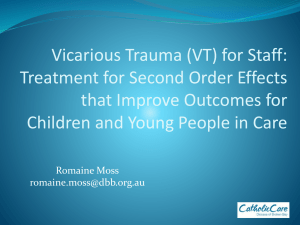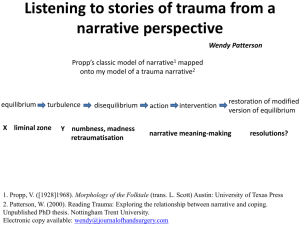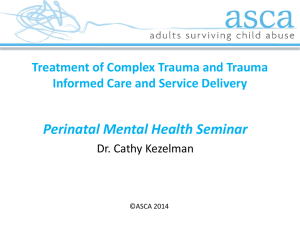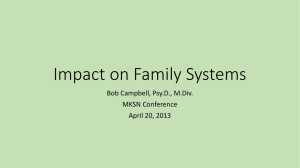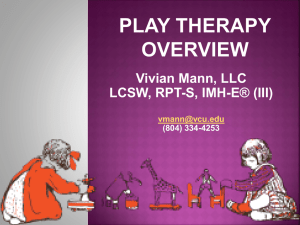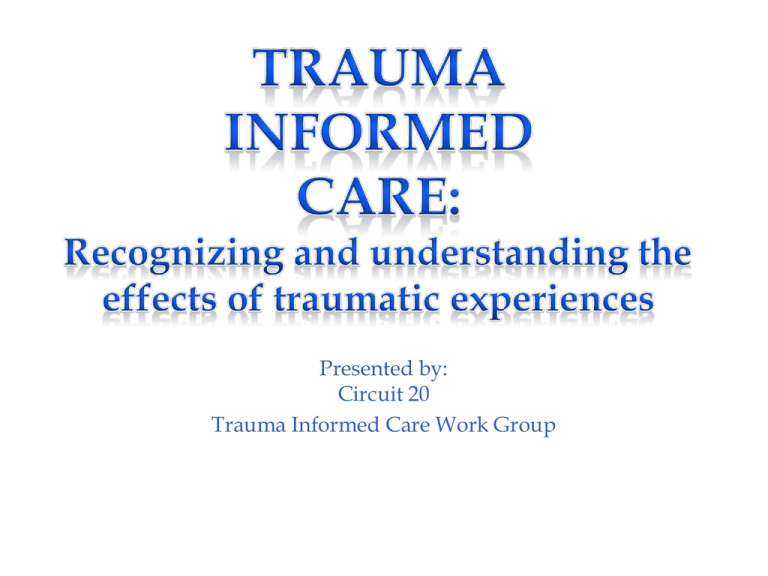
Presented by:
Circuit 20
Trauma Informed Care Work Group
TRAUMA
CAN OCCUR
AT ANY AGE
Trauma can affect
any:
• RACE
•GENDER
•ETHNICITY
•SOCIOECONOMIC
GROUP
•COMMUNITY
•WORKFORCE
Definition (NASMHPD,2006)
The experience of violence and victimization including sexual abuse,
physical abuse, severe neglect, loss, domestic violence and/or the
witnessing of violence, terrorism or disasters
DSM IV-TR (APA, 2000)
Person’s response involves intense fear, horror and helplessness
Extreme stress that overwhelms the person’s capacity to cope
IT IS AN INDIVIDUAL’S
EXPERIENCE OF
THE EVENT……
not necessarily the event
itself that is
traumatizing.
Trauma can occur from:
Trauma can be:
•
•
•
A single event
A connected series of
events
Chronic lasting stress
•
•
•
•
•
•
•
Being in a car accident or
other serious incident
Having a significant health
concern or hospitalization
Sudden job loss
Losing a loved one
Being in a fire, hurricane,
flood, earthquake or other
natural disaster
Witnessing violence
Experience emotional,
physical or sexual abuse
Mental health Treatment that incorporates:
An appreciation for the high prevalence of
traumatic experiences in person who receive
mental health services
A thorough understanding of the profound
neurological, biological, psychological and
social effects of trauma and violence on the
individual
(Jennings, 2004)
•
•
The APA’s DSM IV defines a “traumatic event” as one in
which a person experiences, witnesses, or is confronted with
actual or threatened death or serious injury, or threat to
physical integrity of oneself or others. A person’s response to
trauma often includes intense fear, helplessness or horror.
Trauma can result from experiences that are “private”:
•
•
•
•
Sexual assault
Domestic violence
Child abuse/neglect
Witnessing interpersonal violence
Trauma can also result from “public” experiences:
•
•
•
War
Terrorism
Natural disaster
Trauma is becoming
increasingly
recognized as a
significant factor
in a wide range of
health, behavioral
health & social
problems
Trauma is a central
mental health concern
and the one
“common
denominator”
of all violence & disaster
victims
Slightly more than ½ of all women in the U.S. will be exposed
to at least one traumatic event in their lifetime (Kessler et al,
1995)
The lifetime prevalence of trauma exposure revealed that
51% of women & 61% of men had experienced at least one
traumatic event in their lifetime (Kessler et al, 1995)
Women report exposure to a range of traumatic events.
Although estimates vary, finding suggest that between 17%
& 34% of women will experience a rape at some point in
their lifetime (Brener et al, 1999;Tjaden et al, 2000)
Women are also at higher risk for sexual molestation,
childhood parental neglect, childhood physical abuse,
domestic violence and the sudden death of a loved one
(Kessler et al, 1995;Norris et al, 2002)
FROM
“WHAT
IS
WRONG
WITH
YOU?”
TO
“WHAT
HAS
HAPPENED
TO
YOU?”
The majority of adults & children in
psychiatric treatment settings have trauma
histories
A sizable % of people with substance use
disorders have traumatic stress symptoms
that interfere with achieving or maintaining
sobriety
A sizable % of adults & children in the prison
or juvenile justice system have trauma
histories
( Hodas, 2004, Cusack et al., Mueser et al., 1998, Lipschitz et al., 1999, NASMHPD, 1998)
National survey of 5,877 people aged 15-54
concluded that trauma is very common
60.7% of men and 51.2% of women
reported experiencing a traumatic event
at some point in their lives
10% of men and 6% of women reported
experiencing four or more types of trauma
(kessler, et al,1995)
Tolin & Foa conducted an analysis in 2006 of existing
research on prevalence of traumatic events and
severity of PTSD, looking specifically at sex differences.
They found the following:
Females were significantly more likely to report experiencing
adult sexual assault and child sexual abuse
Males were significantly more likely to report accidents &
non-sexual assault, regardless of age. Male adults, warrelated events, disaster or fire, witnessing death or injury and
illness were more common
For childhood experiences, no differences were found for:
child abuse/neglect, war-related events, disaster or fire,
witnessing death or injury, or illness
*UNIVERSAL PRECAUTIONS*
Presume that EVERY person in a
treatment setting has been exposed
to abuse, violence, neglect, or other
traumatic events
We need to presume the clients we
serve have a history of traumatic
stress and exercise
“Universal Precautions”
by creating systems of care that
are
trauma-informed
(HODAS, 2005)
Trauma Informed
Recognition of high
prevalence of trauma
Recognition of
primary and cooccurring trauma
diagnoses
Assess for history and
symptoms of trauma
Recognition of culture
and practices that
are re-traumatizing
Non Trauma Informed
Lack of education on
trauma prevalence &
“universal
precautions”
Over diagnosis of
Schizophrenia,
Bipolar, Conduct
Disorder & Addictions
Cursory or no trauma
assessment
“Tradition of
Toughness” valued as
best care approach
Trauma Informed
Power/control
minimized-constant
attention to culture
Caregivers/supporters
-COLLABORATION
Address training
needs of staff to
improve knowledge,
sensitivity and
understanding
Non Trauma Informed
Keys, security
uniforms, staff
demeanor, & tone of
voice
Rule enforcersCOMPLIANCE
“Patient blaming” as
fallback position
without training
Recovery is…
“ a process, an outcome and a
vision. We all experience
recovery at some point in our
lives from injury, from illness, from
loss or from trauma. Recovery
involves creating a new personal
vision for one’s self
( Spaniol, Gagne, & Koehler, 1997)
…a common human experience
and a deeply personal, unique
process of changing one’s
attitudes, values, feelings, goals,
skills or roles toward our
understanding of mental illness
(Anthony, 1993)
EMPOWERMENT
INDEPENDENCE
RESPONSIBILITY
CHOICE
RESPECT & DIGNITY
HOPE
Peer delivered services
Self-help techniques
Emphasis on recovery
Understanding the relationship between
trauma and mental illness
Cognitive Behavioral Therapy (individual therapy)
Medication Management-new medications
EMDR: Eye Movement Desensitization &
Reprocessing
Staff members provide:
Encouragement
Support
Education
Acceptance
Choices
Information
Understanding
Respect
HOPE
You have come a long
way
You are a strong person
I admire your courage
in dealing with this pain
I encourage you
Don’t give up
I can’t promise, but I will
do my best to help
I don’t understand.
Please tell me what you
mean
You are doing well
How can I help you
I am here for you
We can work together
through this
It is OK to feel like that
I accept you the way
you are
What do you need at
this time
The most important person in any business
Is not dependent on us…..We are
dependent on them
Is not the interruption of work, but the
purpose of it
Customers do us a favor when they
come…..We aren’t doing them a favor by
waiting on them
Stay calm
Show empathy
Show respect
LISTEN
Reflect what they have said
DON’T ARGUE
Think
Know your procedure (get Supervisor if needed)
Explain policy and procedure
Be willing to “go the extra mile”
Keep customers’ best interest in mind
IT’S NOT WHAT YOU SAY BUT HOW YOU SAY IT
Voice tone counts for 38% of the message
sent….this increases to 90% when using the
telephone
You may be the first contact with the agency so
make it a GOOD experience
Smile
Be Courteous, Attentive and Pleasant





